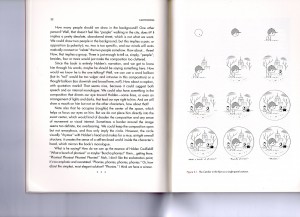 Cartooning: Philosophy and Practice (Yale University Press, 2010; 78 pages; $13)
Cartooning: Philosophy and Practice (Yale University Press, 2010; 78 pages; $13)
If you’re familiar with Ivan Brunetti’s cartoons, you might at first blush not want to take a course from him. His frequently autobiographical comics are loaded with self-loathing (“Turn Your Eyes Inside and Dig the Vaccumm”) and shocking admissions of his distaste for most other human beings (“Hrrlfk! 1,784 Things That Make Me Vomit”). In his (presumably) non-autobiographical work, he often likes to juxtapose quaint old-fashioned newspaper comics styles with images of sexual depravity (“America’s Sweethearts Smelly Ass & Fisty in ‘Piles o’ Fun’”).
Brunetti’s brilliant, of course. He practices a bracing sort of honesty that tests the boundaries of taste as a natural exercise in “what’s next?”:You find downtrodden, depressive Peanuts types amusing? Well, how about the hopeless and suicidal, then? You find memoir-style indie comics eye-opening? Well, how about an entire page of tiny-print soliloquoy? You find comics about single-minded obsessives or casually violent dopes or the frantically lovelorn hilarious? Well, look out!!
The examples listed above all come from Misery Loves Comedy, a hardbound collection of the first three issues of Brunetti’s Schizo comic book augmented with “Horrifying Early Work,” “Contributions to Various Periodicals” (mainly other indie artists’ publications; he has since done some New Yorker covers and other high-profile work) and some beautifully printed color pieces (including “The Thurber Carnivore,” which is not the only extensive appreciation of James Thurber in the collection).
Brunetti comes off not as anti-intellectual but anti-artifice, which is a bracing way for an artist to behave. It raised a few eyebrows when he served as editor for Yale University Press’ Anthology of Graphic Fiction, Cartoons and True Stories, but he proved to be an inspired choice, as you might suspect from the book’s very title. The wide-ranging compendium earned a follow-up volume, and in lieu of a third volume (Brunetti notes in his appendix to Cartooning: Philosophy and Practice that he “will leave that endeavor to the ages, or at least to a much younger, less broken human being”), Yale Press is now publishing his self-described “classroom in a book,” which the author goes on to state gives readers “all the benefits of taking the cartooning course I teach, minus the distractions of the instructor’s monotonous, droning voice, chronic absent-mindedness, soporific slideshows and soul-crushing critiques.”
Imagine how many English and History professors would love a chance to publish their course curricula and reading lists in book form! Those guys in the older disciplines can dream on, but comics is still such a young field in academia that anything published about how to teach and appreciate it has immediate merit. Brunetti is appropriately humble, and typically self-deprecating, about being given the opportunity to publish his classroom preparations. At the same time, those very apprehensions have clearly led to an extra level of effort being put into the lectures and assignments. Brunetti notes that he has had “a wide variety of students, ranging from the deeply perceptive and analytical [who taught me a few things] to one who took the class simply to ‘keep out of trouble on Wednesday nights,’” and seems to expect an equally, if not more, diverse lot for this book version of the course.
I read Cartooning: Philosophy and Practice just for fun—as a fan of the artist and not as a potential pupil—and got a lot out of it.
The book presents you with a much less disturbing Brunetti—two steps removed from his hardcore indie comics, one step removed from the tastes he revealed as an anthology editor—but a no less forthright or outspoken one. His opinions shape the text. His own drawings illustrate it—original art through which he delves into his sometimes quirky assignments by attempting them himself. Brunetti breaks down an entire novel, Catcher in the Rye, into a single cartoon panel, showing how he did by stages of text and image removal. He gives his own take on exercises associated with cartoonists Chris Ware (“the eyebrow to eyebrow transition”) and James Kochalka (the daily diary in four-panel strip format). His page illustrating “some common pitfalls” of cartooning (“inconsistent character design,” “awkward compositions, more easily seen if upside down,” etc.) is as entertaining as it is illuminating, and made further endearing by this captioned comment: “Note, however, that all of these can be subverted and used to the artist’s (and narrative’s) advantage.”
Truly a teacher who’s scared of imparting any hard-and-fast rules, Ivan Brunetti becomes a radical in academic attire. Cartooning isn’t an upper-crust university-press caricature of those old mainstream “how to draw” manuals—it’s a subversive and realistic introduction to the still-maligned, often misunderstood yet increasingly scrutinized world of cartooning today. You couldn’t hope for a more self-aware, down-to-earth yet mindfuckingly stimulating handbook.
